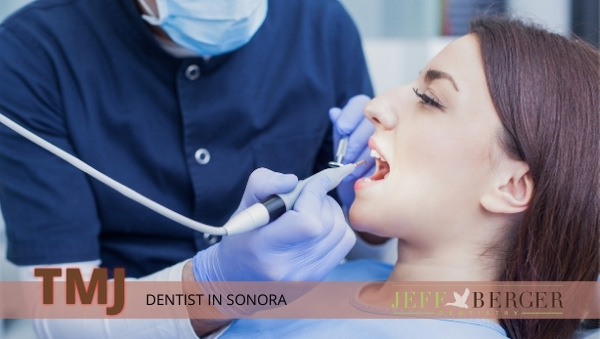TMJ stands for Temporomandibular Joint Disorders, but it is better known as “lock-jaw.” At it’s worst, that is a perfect description of TMJ syndrome. The Temporomandibular joint is the hinged joint that connects your jaw to your skull just in front of your ears. If you have any TMJ symptoms, it is best to schedule an appointment with a TMJ dentist at your earliest convenience to receive a proper diagnosis and begin an effective treatment.
The Possible Causes of TMJ
 There are many ways to damage this joint, any of which can contribute to TMJ. Injuring your jaw, injuring your teeth, grinding your teeth, misalignment of the jaw or teeth, arthritis, stress, bad posture, genetics, and even excessive gum chewing can all be contributing factors. Higher risk groups include people with osteoporosis, osteopenia, rheumatological conditions, migraines, and fibromyalgia. According to Health.com, the National Institute of Dental and Craniofacial Research (NIDCR) estimates that more than 10 million Americans suffer from this syndrome, but scientists don’t yet have real answers about what causes it.
There are many ways to damage this joint, any of which can contribute to TMJ. Injuring your jaw, injuring your teeth, grinding your teeth, misalignment of the jaw or teeth, arthritis, stress, bad posture, genetics, and even excessive gum chewing can all be contributing factors. Higher risk groups include people with osteoporosis, osteopenia, rheumatological conditions, migraines, and fibromyalgia. According to Health.com, the National Institute of Dental and Craniofacial Research (NIDCR) estimates that more than 10 million Americans suffer from this syndrome, but scientists don’t yet have real answers about what causes it.
TMJ Symptoms
The obvious symptoms of TMJ are when your jaw locks in a specific position and you are unable to open or close your mouth. That is also the most extreme TMJ symptom. Other TMJ symptoms include the following:
- Pain in one or both of your Temporomandibular joints
- Clicking or popping sound when chewing
- Aching pain in and around your ear
- Grating sensation when chewing
- Swelling at the jaw
- Difficulty chewing
- Pain while chewing
- Aching facial pain
- Muscle spasms in the jaw
- Numbness in the jaw
- Dizziness or vertigo
- Perhaps most commonly, tightness in the joint, making it difficult to open or close your mouth
Diagnosing TMJ
Because Temporomandibular Joint Disorders are a cluster of conditions affecting the joints in your jaw, diagnosing the condition and prescribing the correct treatment is not always easy. Fortunately, Dr. Berger excels at this and is widely recognized as one of the best TMJ dentists in Sonora. Dr. Berger will begin with a simple observation: observing the range of motion in your jaw, looking at and listening to your jaw open and close, and visually inspecting your mouth. He may also press on part of your jaw to identify the exact location of your pain and feel the functionality of your jaw in motion.
Don’t worry. Dr. Berger understands that you are coming to him because you are looking for relief from pain; he will be very gentle. Dr. Berger will also discuss your medical history with you, and it is important to alert him if you have any of the high-risk factors we identified above. Typically, a TMJ dentist will conduct some sort of imaging to make certain they have the correct diagnosis. These may include x-rays, CT scans, or MRIs, though the last is fairly rare. These tools will enable Dr. Berger to make sure that you are properly diagnosed so that you can get the proper treatment.
TMJ Treatments
 The good news is that the majority of people who suffer from the disorder can get significant relief from their TMJ symptoms with affordable, non-invasive treatments. In fact, a certain percentage of people find that TMJ symptoms can gradually fade away without any treatment, but simply by resting the joint and applying cold compresses. If you use over the counter anti-inflammatories, such as aspirin, acetaminophen, or ibuprofen, they may also help with TMJ. If prolonged use of medication is required to maintain a normal lifestyle, it is best to see a TMJ dentist. For those who need professional assistance, here are some of the more popular treatment options:
The good news is that the majority of people who suffer from the disorder can get significant relief from their TMJ symptoms with affordable, non-invasive treatments. In fact, a certain percentage of people find that TMJ symptoms can gradually fade away without any treatment, but simply by resting the joint and applying cold compresses. If you use over the counter anti-inflammatories, such as aspirin, acetaminophen, or ibuprofen, they may also help with TMJ. If prolonged use of medication is required to maintain a normal lifestyle, it is best to see a TMJ dentist. For those who need professional assistance, here are some of the more popular treatment options:
Medications for TMJ
- Muscle relaxants – Muscle relaxants can be useful medications for short-term treatments (a few days or weeks). This can help relieve pain caused by TMJ disorders created by muscle spasms and increase range of motion. If symptoms persist, other alternatives should be explored.
- Tricyclic antidepressants – Though most commonly used to treat depression, these medications, such as amitriptyline, can be used in low dosages for pain relief, bruxism control, and sleeplessness.
TMJ Therapies
- Occlusal appliance – There are a variety of occlusal appliances designed to help with TMJ. These include several different types of oral splints or mouth guards. These are key for folks who grind their teeth but can help in other cases, as well. Many patients with jaw pain benefit from having a padded device inserted over their teeth, particularly when they sleep.
- Physical therapy – There are a number of different exercises patients can try to stretch and strengthen jaw their jaw muscles. It is not dissimilar from physical therapy patients sometimes take following accidents or surgery, and can be both taxings at the time, and helpful afterward.
- Injections – Corticosteroid injections into the joint, administered by a TMJ dentist, may be quite helpful. Other medications, such as Botox may also be used to temporarily immobilize muscles and relieve pain associated with TMJ disorders. You should carefully review these types of injections with the best TMJ dentist in Sonora, Dr. Berger.
Surgery
- Arthrocentesis – Arthrocentesis is typically the preferred surgical option, if plausible. It is a minimally invasive procedure that involves the insertion of small needles into the TMJ joint. The goal is for fluid to be irrigated through the joint to remove any debris or scar tissue.
- Modified condylotomy – A modified condylotomy attempts to treat TMJ symptoms indirectly, with surgery on the mandible (jaw bone), but not in the TMJ joint itself. These typically only used in the case of a specific set of symptoms.
- TMJ arthroscopy – In many cases, arthroscopic surgery can be as effective for treating various types of TMJ disorders as open-joint surgery with much less invasive incisions. A cannula, which is a thin tube, can be placed into the joint through a tiny hole. An arthroscope and small surgical tools can then inserted to perform the procedure On the plus side. TMJ arthroscopy has fewer risks and complications than open-joint surgery does. On the downside, it has some limitations and may not offer as comprehensive a “clean out” or repair as an open joint surgery.
- Open-joint surgery – If there is a structural problem in your joint, your dentist may have to resort to open-joint surgery. This allows the most extensive joint repair can even involve replacing the joint. Open-joint surgery has higher risks than other procedures do, tends to leave a larger scare, and should be considered thoughtfully after a thorough discussion with your dentist, and a thorough review of your TMJ symptoms.
 What to Look for in a TMJ Dentist
What to Look for in a TMJ Dentist
Because Temporomandibular Joint Disorders can be caused by a variety of conditions affecting the joints in your jaw, diagnosing the condition and prescribing proper treatment is not always simple. Fortunately, Dr. Berger is widely recognized as one of the best TMJ dentists in Sonora.
The three keys you should look for in a TMJ dentist are experience, expertise, and patient care. As one of the most experienced TMJ doctors in Sonora, Dr. Berger is an expert in the field. He and his team understand the pain and frustration you face. You won’t find a better TMJ dentist team to care for your needs. Please call us at 209-532-2915 and let us help alleviate your TMJ symptoms as soon as possible.